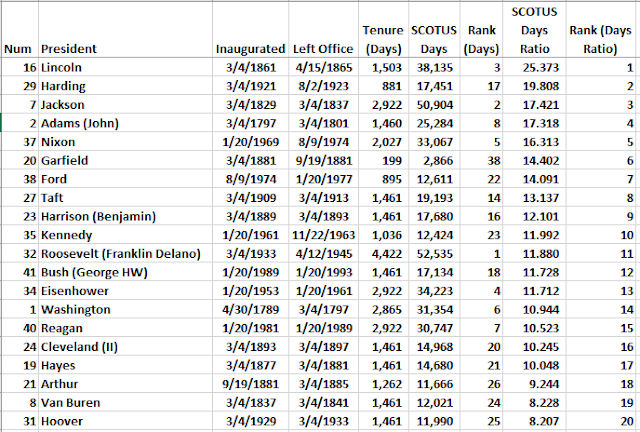As a result, I came up with a StoopidStats-based way of measuring such influence.It comes down to two statistics:
- SCOTUS Days: Is designed to be a measure of a President's impact on the court without any consideration of how long the President served. It is the total number of days served on the court by justices the president picked.*
- SCOTUS Days Ratio measures a president's influence relative to the length of his tenure as President. It is SCOTUS Days divided by the number of days the President served.
The full file is here.
It's not terribly surprising that Franklin Delano Roosevelt has the most SCOTUS Days, with 52,535. He served more than three full terms, which is longer than anyone else, and picked eight SCOTUS justices. George Washington picked 11 justices -- SCOTUS was a new thing, and he had to pick all the original justices. But they served much shorter terms.
But, while Roosevelt has more SCOTUS Days than any other President, he is 11th in SCOTUS Day ratio, at 11.880. First is Abraham Lincoln, with a ratio of 25.373. He has over 38 thousand SCOTUS Days, resulting from a presidency that lasted a little more than one term.
A few interesting notes:
- There have been four Presidents who never got to pick a SCOTUS justice: William Henry Harrison, John Tyler, Andrew Johnson and Jimmy Carter. Carter is the only one of those who served a full term.
- Of those who did pick a justice, John Quincy Adams is the only one whose ratio is below 1. This means that the justices he picked (OK, there was only one) collectively served less time on the court than he did as President.
- Mahlon Pitney was on the court for exactly 4,000 days.
* Few notes about methodology. I treated Cleveland's two nonconsecutive terms as separate presidencies. All statistics are as of this coming December 31, with the assumptions that Trump is still President at that point and the makeup of the court remains the same until then.

No comments:
Post a Comment